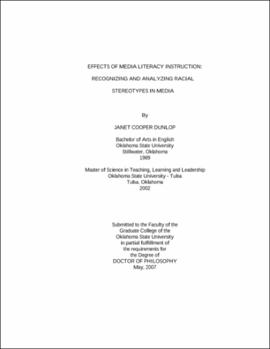| dc.contributor.advisor | Schwarz, Gretchen | |
| dc.contributor.author | Dunlop, Janet Cooper | |
| dc.date.accessioned | 2013-11-26T08:34:24Z | |
| dc.date.available | 2013-11-26T08:34:24Z | |
| dc.date.issued | 2007-05 | |
| dc.identifier.uri | https://hdl.handle.net/11244/7377 | |
| dc.description.abstract | Scope and Method of Study: The purpose of this study was to determine whether media literacy instruction that encourages critical consumption of media also affects students' abilities to recognize, deconstruct and analyze racial stereotypes in media. Over two years, this study focused on the effects of media literacy instruction on students' abilities to recognize and analyze racial stereotypes in television. The participants were in 10th-12th grade and consisted of two classes (34 students), one in 2005 and one in 2006. Students participated in ten days of media literacy instruction (ten hours of class time) in a suburban Midwestern high school sociology and anthropology class. Students were administered pre and post measurement to determine effect of media literacy instruction. | |
| dc.description.abstract | Findings and Conclusions: Findings reveal that media literacy instruction changed the way the students perceived racial stereotypes on television. First, students' responses to television clips with racial stereotypes were much more complex after media literacy instruction. Coding patterns revealed that while pre-instruction responses reflected four categories, "I see," "Other people," "I don't know," and "Us vs. them," post-instruction revealed two more categories, Defensiveness and Anger. The emotive nature of these two categories suggests a deeper level of critical analysis and an internalization of media literacy curriculum. Simply put, the students as a group were more emotionally vested in the analysis of racial stereotypes in media after media literacy instruction. Secondly, findings reveal that students were more aware of racial representation after media literacy instruction. Coding patterns revealed that pre-instruction identification of white as a racial category was rare, but post-instruction identification of white as a racial group was commonplace. In addition, post instruction responses revealed a heightened awareness of the lack of minority representation on television. | |
| dc.format | application/pdf | |
| dc.language | en_US | |
| dc.rights | Copyright is held by the author who has granted the Oklahoma State University Library the non-exclusive right to share this material in its institutional repository. Contact Digital Library Services at lib-dls@okstate.edu or 405-744-9161 for the permission policy on the use, reproduction or distribution of this material. | |
| dc.title | Effects of media literacy instruction: Recognizing and analyzing racial stereotypes in media | |
| dc.contributor.committeeMember | Takacs, Stacy | |
| dc.contributor.committeeMember | Brown, Pamela | |
| dc.contributor.committeeMember | Stansberry, Susan | |
| osu.filename | Dunlop_okstate_0664D_2196 | |
| osu.accesstype | Open Access | |
| dc.type.genre | Dissertation | |
| dc.type.material | Text | |
| thesis.degree.discipline | Teaching and Curriculum Leadership | |
| thesis.degree.grantor | Oklahoma State University | |
